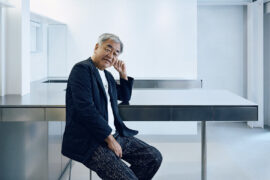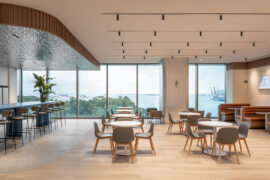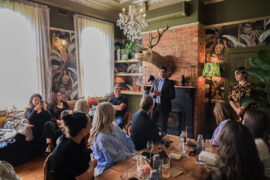With a rapidly growing global population that is becoming increasingly urbanised, competition for space and resources in our cities is fierce.

October 16th, 2024
The Sustainability Awards and Summit are brought to you by Architecture & Design. For over a decade and a half, Architecture & Design has hosted the Sustainability Summit – a beacon of insight into sustainable practices, and this year promises to be no different as it once again takes centre stage, this time on an engaging virtual platform.
University of Technology Sydney Faculty of Science Director, Plants and Environmental Quality Research Group Associate Professor Fraser Torpy is adamant: the evidence is growing that the best way of mitigating almost all of the environmental challenges we face in the cities of today and tomorrow is through natural systems based on plants.
“Green systems, including green roofs and walls, are the most space and service efficient way to introduce functional biological systems into crowded urban areas. Whilst the evidence for the benefits provided by these systems is very strong, there is still resistance amongst building designers and owners based on perceptions of return on investment and value for money,” Torpy says.
School of Civil and Environmental Engineering, University of Technology Sydney Fellow and Lecturer in Air and Noise Pollution Peter Irga ARC DECRA concurs: A thicker layer of growing media can hold more stormwater and support a more diverse range and quantity of plants. However, increasing the thickness also raises installation costs and adds more weight, which in turn increases the structural load.
“Green roofs come with higher initial costs compared to other options, and their economic benefits are not well understood, leading to their perception as a luxury rather than a practical choice,” he says.
“Insufficient knowledge about how green roofs perform and their impact on achieving a sustainable building has resulted in them being neglected not just in public buildings but across many other projects as well.
“Currently, many native wildlife and plant species face significant challenges as they compete with aggressive, invasive species that have no natural predators and are rapidly displacing them. However, green roofs offer a promising opportunity for conservation. By incorporating native plants into these structures, we can create new habitats that support local biodiversity, ultimately contributing to the preservation and restoration of our natural ecosystems.”
According to Irga, amidst the housing crisis, there is a risk of compromising environmental standards. It is crucial to prioritise thoughtful and sustainable land use, including the integration of green roofs, to ensure that the urgency of the situation does not lead to neglecting environmental and social considerations.
University of Melbourne Associate Professor John Rayner is adamant, there are numerous elements to consider when it comes to green roofs:
– Making sure that at the start of, and during, the design process that professional expertise is engaged to ensure that the proposed design outcomes can be delivered.
– Obviously this often includes architectural and structural engineering advice, but consultation with a landscape professional can also help, particularly one with green roof expertise.
– Common challenges with the design of green roofs include structural loadings, access issues, planting design and plant selection, establishment difficulties, and of course maintenance. Maintenance needs to be built into design considerations for green roofs, but frequently isn’t.
– Every green roof project is different with distinct challenges requiring different solutions.
“We see green roofs as opportunities to integrate various ecological and social concerns. We have used them to incorporate native and endemic plants, increasing biodiversity in urban areas and also emphasising Connection to Country,” says Carol Marra, Director at Marra + Yeh Architects.
According to her, Green roofs are an opportunity for stormwater management, water filtering, capture and reuse within projects, considering how a green roof can fit into the whole water cycle.
“We also use green roofs as a strategy to mitigate heat and improve climate-resiliency, because green roofs create an additional layer of insulation, keeping spaces below cool and comfortable,” Marra says.
“We have successfully used green roofs in adaptive reuse and heritage constrained projects. Even with a relatively minimal depth of soil, it is possible to create vibrant and diverse landscapes by working closely with landscape architects. As much as possible, we emphasise that access to green roofs needs to be easy for insects and pollinators as well as people, to enjoy the benefits of these pockets of nature.”
This panel represents some of the most accomplished leaders in the sustainability field who will explain the current climate of the green roof industry and plant the seeds to help the next generation achieve a much more diverse and sustainable future. To discuss this pressing issue, we will have Carol Marra, Director at Marra + Yeh Architects, Associate Professor Fraser Torpy from the School of Life Sciences UTS, Peter Irga Fellow and Lecturer in Air and Noise Pollution, at the School of Civil and Environmental Engineering, University of Technology Sydney as well as University of Melbourne Associate Professor John Rayner.
The 2024 Sustainability Summit will be held in Sydney on November 14.
To reserve your place at the 2024 Sustainability Summit for this and other sessions, click here.
INDESIGN is on instagram
Follow @indesignlive
A searchable and comprehensive guide for specifying leading products and their suppliers
Keep up to date with the latest and greatest from our industry BFF's!

London-based design duo Raw Edges have joined forces with Established & Sons and Tongue & Groove to introduce Wall to Wall – a hand-stained, “living collection” that transforms parquet flooring into a canvas of colour, pattern, and possibility.

For Aidan Mawhinney, the secret ingredient to Living Edge’s success “comes down to people, product and place.” As the brand celebrates a significant 25-year milestone, it’s that commitment to authentic, sustainable design – and the people behind it all – that continues to anchor its legacy.

In a wide-ranging interview, the iconic Japanese architect joins Timothy Alouani-Roby to discuss his childhood home, the influence of Metabolism, a formative experience in the Sahara desert and a recent house by Mount Fuji.

Rising above the new Sydney Metro Gadigal Station on Pitt Street, Investa’s Parkline Place is redefining the office property aesthetic.
The internet never sleeps! Here's the stuff you might have missed

Bean Buro’s Singapore office for Anglo-Eastern is a poetic continuation of their Hong Kong headquarters — a workplace that balances identity and calm.

Guests joined Cosentino for a behind-the-scenes look at The Block homes, discovering new materials and creative partnerships.